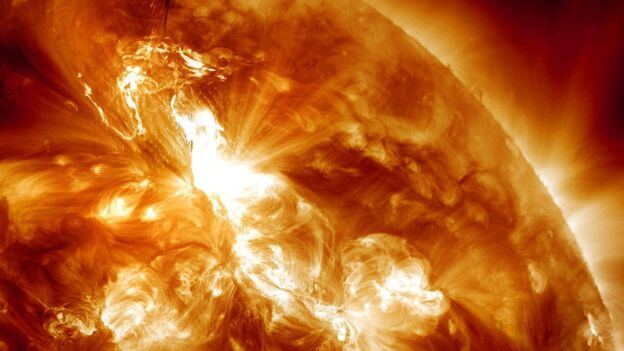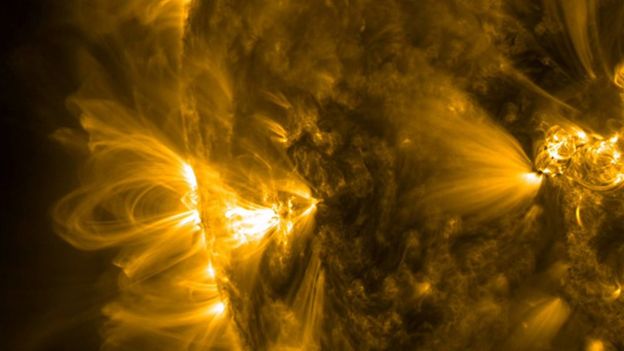For the first time in history, NASA sent a probe to the Sun: why and how is it possible
The Parker space probe, launched on August 12 from Cape Canaveral after the launch was delayed by a day, should fly through the solar corona for the first time in history, actually touching our star, writes BBC Russian Service.

Photo: NASA
The idea of such a mission was discussed from the very beginning of the space age, but it was impossible to accomplish it: on approaching the Sun, any apparatus should elementally melt and burn.
Only recently, technology has allowed the probe to be equipped with sufficient thermal protection, which will allow it several times to fly up to the hot atmosphere of a star, where the temperature reaches hundreds of thousands of degrees.
“We've been studying the Sun for decades, and we're finally going to where it all happens,” said NASA project manager Alex Young on the eve of the launch.
A close stranger
Despite its relative proximity - by cosmic standards, of course - we don't know much about our star.
For example, one of the main mysteries of the Sun is why the outer part of the star's atmosphere is hundreds of times hotter than the surface of the star. It's as if we were getting hotter the farther away we were from the fire.
To the naked eye from the Earth, we can observe only an insignificant part of the solar radiation, therefore the Sun seems to us to be a very calm and unchanging disk.
In fact, in a very real sense, it is constantly being torn apart by powerful explosions, as a result of which streams of charged particles and electromagnetic radiation - the so-called solar wind - are scattered over billions of kilometers around.

Photo: NASA
This discovery was made in the mid-91th century by American astronomer Eugene Parker. It is in his honor that the device is named. The XNUMX-year-old scientist was at the launch site and said goodbye to Parker.
On Earth, gusts of solar wind cause auroras, magnetic storms and other phenomena collectively known as space weather.
Such outbreaks not only affect our well-being, but also interfere with radio communications, disrupt the operation of satellites, and sometimes lead to serious disruptions in the power grids. In the 1989 year, for example, the storm was so powerful that the solar wind completely de-energized the Canadian province of Quebec for several hours, and the northern lights could be seen in Florida and in Texas, where they usually do not exist.
“Our world is constantly bathed in solar energy,” explains Nicky Fox, one of the project leaders from Johns Hopkins University. “But we don’t have a clear understanding of what mechanisms drive the solar wind toward us, and that’s what we’re going to find out.”
However, the mission also has a completely practical meaning. Scientists hope that with this research they can better understand the nature of the solar wind - and perhaps learn how to predict space weather.
For example, in the near future it is planned to send the first people to Mars. The mission will last three and a half years, and if a sufficiently intense flare occurs on the Sun during the flight, then all the astronauts will die. On Earth, the planet’s magnetosphere protects us from cosmic radiation, but in open space it is impossible to hide from the solar wind - its sudden gust can destroy the ship’s electronics and cause irreversible mutations in the crew’s DNA.
Into the thick of it
"Parker" must answer several questions - in particular, why the solar wind is accelerating and how charged particles manage to reach near-light speeds. To do this, he will need to get as close as possible to the Sun, plunging into the upper layers of the star’s atmosphere.
According to one of the mission leaders, Nicolene Viall, “we have the opportunity to stick a thermometer into the very corona (that’s what the outer layers of the Sun’s atmosphere are called - ed.) and see how the temperature rises.”
But how can you “stick a thermometer” into the Sun without it melting?
The probe will be protected from scorching rays by unprecedented thermal protection: a screen made of multilayer carbon fiber about 12 cm thick and a complex system of seven sensors, the task of which is to autonomously, without a signal from the Earth, control that the device is always turned to the Sun with the desired, that is, protected, side.

Photo: NASA
Once “Parker” even partially leans out of the protective screen, the device, which cost $1,5 billion to create and launch, risks, at best, failing, and at worst, turning into a clot of plasma.
To understand how a 12cm screen can protect against the destructive heat of a star, we need to remember the difference between heat and temperature. Temperature measures how fast particles move, while heat measures the total amount of energy they transfer. Particles can move at incredible speeds (high temperature), but if their number is small, then they will not be able to transfer much energy. For example, you can safely stick your hand briefly into a hot oven - but not into boiling water.
In outer space - in conditions of almost complete vacuum - there are negligibly few particles that can heat up the apparatus. The upper layers of the solar corona are extremely rarefied, and although the temperature there reaches millions of degrees, the Parker protective shield will only heat up to 1300-1400 degrees.
At the same time, the device itself will operate in very comfortable conditions of about 30 degrees Celsius, and the “tail” of the three-meter probe, turned away from the Sun, will be completely immersed in real cosmic cold - about 130 degrees below zero. The back of the Parker will even have to be heated additionally so that the electronics located there can work properly.
17 years of waiting
Vladimir Krasnoselskikh is an employee of the French National Center for Scientific Research, his team is responsible for the magnetic sensors of one of the four instruments installed on the Parker, called FIELDS. The purpose of the device is to measure the electric and magnetic fields around the device.
It was the FIELDS developers from the University of Berkeley who came up with the idea of “cockroach whiskers” - thin sensors placed outside the protective screen to more accurately measure the potential difference in the electric field. Vladimir himself compares them to the terminals of a car battery.
Vladimir says that initially, in parallel with Parker, it was planned to launch a similar probe of the European Space Agency. The devices were supposed to take measurements at distances of 10 and 60 radii from the Sun, but the European mission had to be postponed until 2020.
Vladimir began working on the FIELDS project back in 2001, so he had been waiting for this NASA launch for 17 years. The scientist is especially offended that Parker was launched only when it was time for him to retire and he would not be able to recruit his own team to analyze the information collected by the device.
“The launch is not the most interesting for us, we are waiting for the first data,” says Krasnoselskikh. “After all, no one has done anything like this before.” Not only the mission itself is unique, but also our experiment on it.”
At the same time, the device will be able to transmit the measurement data collected on the Sun to scientists only when it returns to Earth—more precisely, when it approaches it at a minimum distance. And this “tour” lasts 88 days - almost three more months of painful waiting after the launch.
At the same time, no one yet knows exactly what results the mission will bring—and when they will be able to find practical application.
Vladimir sadly jokes that the science he is engaged in, on the one hand, is not fundamental enough to receive Nobel Prizes for it (even Eugene Parker himself was not awarded it, despite all his discoveries), and on the other hand, it is not applied enough to willingly allocated money.
“We constantly have to convince people that what we are doing is really necessary,” Krasnoselskikh smiles. “But let’s wait for the next intense flare on the Sun - and then everyone will say: what useful work these scientists did!”
Read also on ForumDaily:
NASA presented projects of residential settlements on Mars. A PHOTO
Perseids-2018: where and how to see the most beautiful meteor shower
How Russian specialists work at NASA
American astronaut NASA adopted a boy from Ukraine
Subscribe to ForumDaily on Google NewsDo you want more important and interesting news about life in the USA and immigration to America? — support us donate! Also subscribe to our page Facebook. Select the “Priority in display” option and read us first. Also, don't forget to subscribe to our РєР ° РЅР ° Р »РІ Telegram and Instagram- there is a lot of interesting things there. And join thousands of readers ForumDaily New York — there you will find a lot of interesting and positive information about life in the metropolis.











